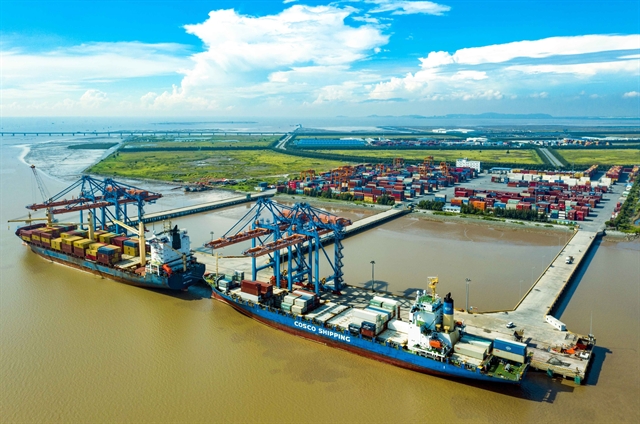 Economy
Economy


|
| Nam Hải Port in the northeastern city Hải Phòng. — VNA/VNS Photo An Đăng |
HÀ NỘI — The Vietnamese economy expanded at 7.72 per cent in the second quarter of this year, the highest rate in the same quarters in the last 10 years, the General Statistics Office (GSO) reported at a press conference on Wednesday.
The figures for the same quarters in the last three years of 2019, 2020 and 2021 were 7.1 per cent, 0.52 per cent and 6.73 per cent, respectively.
In Q2 this year, the agriculture-forestry-fishery sector increased 3.02 per cent, contributing 4.56 per cent to the overall growth of the economy.
The industry and construction sector was up 8.87 per cent, making up 46.85 per cent, while the service sector rose by 8.56 per cent, contributing 48.59 per cent to the general GDP growth, Hương said.
Regarding GDP use, final consumption expenditure increased by 7.32 per cent over the same period last year; accumulated assets rose by 4.57 per cent; exports of goods and services surged 12.33 per cent; and imports of goods and services were up 4.88 per cent.
In the January – June period, the country's GDP grew by 6.42 per cent, higher than the 2.04 per cent and 5.74 per cent growth rates of the same periods in 2020 and 2021, respectively.
According to GSO General Director Nguyễn Thị Hương, the country's socio-economic development in the first six months of 2022 has prospered in most industries and fields, especially the processing and manufacturing industry; retail sales of consumer goods and services; and exports.
In terms of economic structure in the first two quarters, the agriculture-forestry-fishery sector accounted for 11.05 per cent of the country’s economy; the industry-construction and service sectors made up 39.3 per cent and 40.63 per cent, respectively, the GSO said.

|
| GSO General Director Nguyễn Thị Hương speaks at a conference held by the General Statistics Office (GSO) on Wednesday. — VNS Photo Linh Anh |
CPI up 2.96 per cent in Q2
The Consumer Price Index (CPI) in the second quarter of 2022 posted a year-on-year rise of 2.96 per cent.
The office said CPI in June increased by 0.69 per cent month-on-month, up 3.18 per cent against December 2021 and up 3.37 per cent compared to the same period last year.
GSO General Director Nguyễn Thị Hương attributed the increase in CPI in Q2 to the continuous hikes in domestic petrol prices in tandem with world fuel prices, as well as the increase in the price of essential consumer goods and services in line with the price of input materials and transportation costs.
On average, in the first six months, CPI increased by 2.44 per cent over the same period last year; core inflation rose by 1.25 per cent.
The global commodity market continued to face fluctuations in the first half of 2022 and was influenced by economic and political factors, Hương said.
“The world economy recovered, the demand for raw materials for production increased while the supply was interrupted, causing commodity prices on the international market to soar,” she said.
“The tensions between Russia and Ukraine have pushed up the prices of raw materials and fuel and the world is at risk of a global food crisis,” she said.
In the second quarter of 2022, domestic petrol prices increased by 54.92 per cent over the same period last year, causing the overall CPI to increase by 1.98 percentage points. Domestic gas prices increased by 30.99 per cent over the same period last year, causing CPI to increase 0.45 percentage points.
The price of housing maintenance materials in Q2 went up by 7.81 per cent over the same period last year because the prices of cement, iron, steel and sand increased according to the price of input materials, causing the overall CPI to increase 0.16 percentage points.
The domestic price of rice also gained in line with the export prices of rice. In the second quarter, it increased by 1.07 per cent over the same period last year, causing the overall CPI to increase by 0.03 percentage points.
Besides the reasons for the increase in CPI, there are some reasons for the decrease in CPI in the second quarter of 2022, including the average pork prices down 18.6 per cent compared to last year due to the control of African swine fever and the guaranteed supply of pork, reducing CPI by 0.63 percentage points.
The fees of educational services in Q2 dropped by 2.86 per cent because a number of provinces and centrally-run cities exempted and reduced tuition fees from the first semester of the 2021-2022 school year due to the impact of the COVID-19 pandemic, causing CPI to decrease by 0.16 percentage points.
House rent in the second quarter of this year decreased by 12.33 per cent compared to last year because due to the COVID-19 pandemic, many landlords reduced rent to support tenants. — VNS




